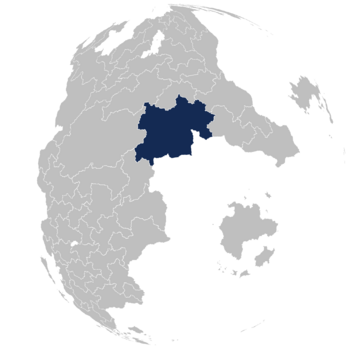Sartoria
This article is incomplete because it is pending further input from participants, or it is a work-in-progress by one author. Please comment on this article's talk page to share your input, comments and questions. Note: To contribute to this article, you may need to seek help from the author(s) of this page. |
Principality of Sartoria Principato di Sartoria | |
|---|---|
|
Flag | |
 | |
| Capital | Messelia |
| Largest city | Chiavere |
| Official languages | None |
| Other languages | Sartorian |
| Demonym(s) | Sartorian |
| Government | Federal Elective Parliamentary Monarchy |
• Princess | Giulia |
• First Councillor | Luciana Bergamaschi |
• Second Councillor | Fiorella Scola |
• Senate Speaker | Roberta Casellati |
• Chief Justice | Mario Boldrini |
| Legislature | Senate |
| Establishment | |
• Treaty of Messelia | 1768 |
• Merger Treaty | 1908 |
• Treaty of Regù | 1921 |
| Area | |
• Total | 3,078,415 km2 (1,188,583 sq mi) |
| Population | |
• Estimate | 186,723,882 |
• Density | 60.7/km2 (157.2/sq mi) |
| GDP (nominal) | estimate |
• Total | S/ 7,357 trillion |
• Per capita | S/ 39,400 |
| Currency | Vallo (v) |
| Time zone | UTC-5 |
| Date format | DD/MM/YYYY |
| Driving side | left |
| Internet TLD | .sr |
Sartoria, officially the Principality of Sartoria (Sartorian: Principato di Sartoria) is a country in Central Arcadia. It is located southwest of the Artemid Peninsula, bordering Istria to the west, Meridia to the southwest, Adler and Delfina to the east, and the Sartorian Sea to the south. With over 186 million inhabitants, it is the most populous country in Arcadia, and the second most populous country in the world.
Sartoria has long been settled by a number of civilisations, most notable the Artemid Empire in the east and the Vasarian Empire in the centre and southwest. Unification began in the 18th century when Messelia and Verale, two of the leading industrial realms at the time, merged into a single country called Sartoria. As more realms joined, the country grew from a confederacy to a federal principality.
By the late 19th century, present-day Sartoria was divided into several states; the main ones, in terms of size, population, economic development and military power, were Sartoria, North Sartoria and Laminia. Following the Sartorian-Laminian War and the Peninsular War, Laminia was split into two and annexed by Sartoria and North Sartoria, who then merged into a single country through the 1908 Merger Treaty. Unification was finally concluded when Tavoletro acceded to the Principality, amid concerns that Sacuri Thought was getting out of control in the area.
In the 1920s and 1930s, Sartoria waged war on the Sacuri, the third such conflict in its history, after the First War in the 13th century and the Second War in the 17th century. When the Order of the Bloody Hand conquered large swaths of the Eastern Realms and invaded Messelia, the Sartorian Government began an unprecedented military campaign that resulted in the final defeat of the Sacuri in 1935. After the War, the Cleansing Act allowed the Government to erase all Sacuri influence from society.
In the 1960s, Sartoria fought in the Great War alongside Parthenopias and Selene, where the Iron Alliance was kept from expanding its territory beyond their national borders, though at great cost in terms of lives and infrastructure. After the War, the three countries formed the Artemian Union, a political, military and economic alliance that survives to this day.
Today Sartoria is the world’s largest economy, with a very high level of human development and high rankings in socioeconomic indexes. It is a member of the World Society, the Artemian Union and several other international organisations.
Etymology
The origin of the name Sartoria goes back to the epic poem tradition of the Vasarian Empire. One such poem, the Song of the Horse, refers to a mythical horse called Sartor, which would come to the assistance of worthy heroes in Vasaria's times of greatest need.
Over the years, the name Sartoria was used to refer to the land of the horse. There is no certainty of when this name was first used; the first written record of its use is from an imperial decree that referred to "the legacy of Vasaria as Sartoria, the land ever-protected".
By the 18th century, the name Sartoria was a common way of referring to the southern and southeastern areas of the present-day country. When Messelia and Verale discussed the prospect of a merger, as a way of integrating their industrial capabilities, Sartoria was overwhelmingly accepted as the name for the new country.
Politics
Sartoria is a federal elective parliamentary monarchy. Governance is regulated by the Charter of the Principality of Sartoria, which integrates the various treaties that were signed during the Unification process.
Government and Politics
Sartoria's head of state is Princess Giulia Scavino, who was elected by the Court of the Realms in 2018 for a lifetime term, though convention has the monarch resign after 15 years. The Princess is expected to appoint the Privy Council, sign or return bills, and remain an apolitical actor that represents the unity of Sartoria. The Princess resides in the Royal Palace, in Messelia, but dedicates a significant amount of time visiting the various realms and meeting with their governments to hear their concerns.
The Government is led by First Councillor Luciana Beragamaschi. Barring exceptional circumstances, the First Councillor is always a Privy Councillor who has secured the confidence of the majority of the Senate; this also means that they only serve for as long as they maintain that confidence. Once appointed by the Princess, the First Councillor designates the Privy Council's Executive Committee, which is the primary governing body of Sartoria.
Unlike the parliamentary system of other countries, in Sartoria the executive branch is accountable to the Senate, but is not a part of it. The only senator who sits on the Executive Committee is the Second Councillor, who is simultaneously the leader of the majority coalition and coordinates with the First Councillor the government's legislative agenda. The current Second Councillor is Fiorella Scola, Chair of the Alliance for a Sustainable Development (ASS).

The Senate is the unicameral legislature of Sartoria, consisting of 408 senators who are elected every three years using open list proportional representation. Senators represent their respective realms, rather than single-member districts. The Senate is empowered to conduct legislative, investigative and oversight business, and is led by a Speaker who, much like the Princess, is expected to maintain political neutrality.
The current governing coalition is the Green Coalition, which holds a 67% supermajority. It is led by the Alliance for a Sustainable Development and composed of the Social Progress Party (PPS), the Youth Movement (MG), the Liberal Party (PL) and the Socialist Party (PS). In opposition sit the Merchant Rights Alliance (ADM), Forward (AV) and the Movement for Renewal (MR). Mario Salucci serves as the Leader of the Opposition, in his capacity as Speaker of the ADM, and therefore the leader of the largest non-government party in the Senate.
The Court of Review is the highest court in Sartoria. It is composed of a Chief Justice, who also leads the federal judiciary, and eight Associate Justices, all appointed by the Princess, with the advice and consent of the Privy Council, for a term of seven years. Its duties comprise the following:
- Hear appeals in cases where constitutional rights may have been violated
- Review the constitutionality or legality of laws, ordinances, rules and actions
- Provide advisory opinions to the Princess on bills passed by the Senate
- Try officials indicted by the Privy Council or the Senate
As a court of final instance, the Court of Review has discretionary authority and may refuse to hear cases; in the case of advisory opinions and trials of indicted officials, it also has the authority to delegate responsibility to the Courts of Appeals, the second tier in the federal judiciary. Unless the matter refers to a constitutional amendment or the trial of the Princess, the Court of Review will usually delegate responsibility.

